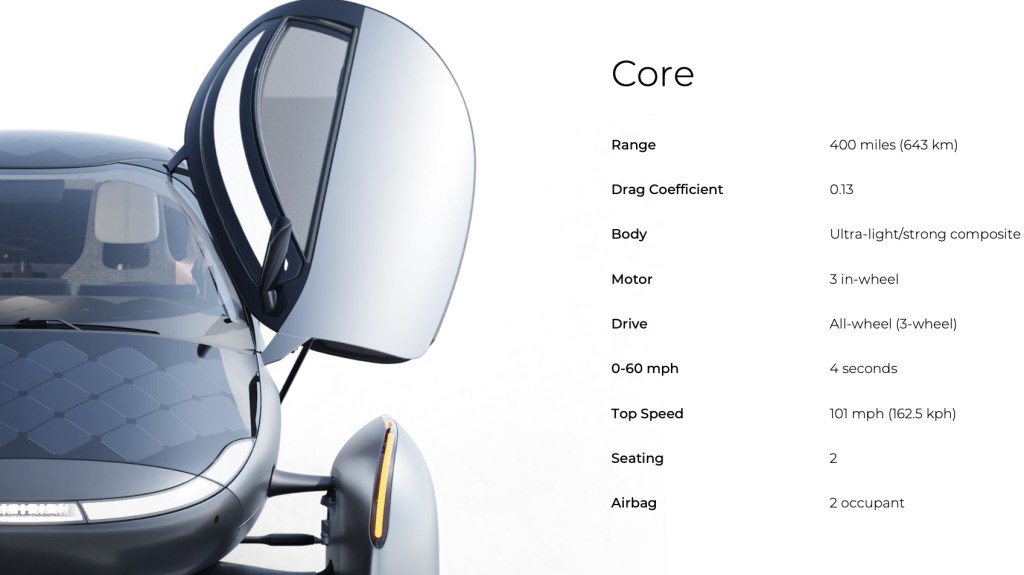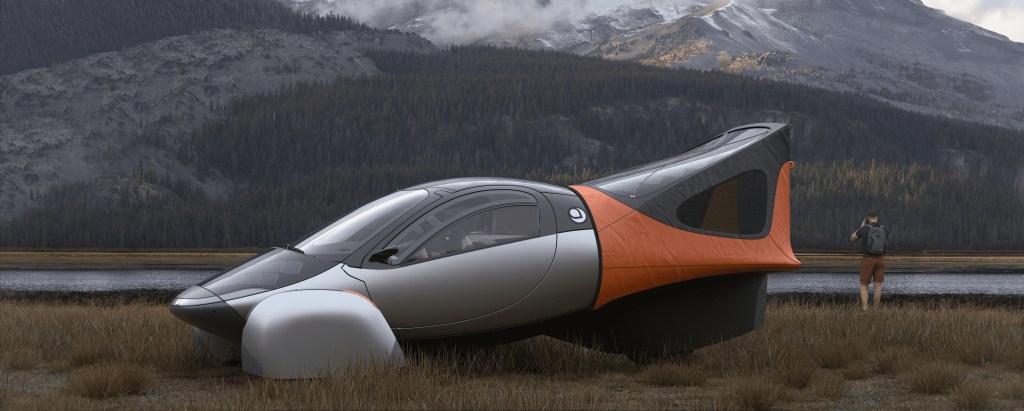Aptera solar-powered car promises no more plugging in — for southern Californians, at least
Might not be so effective in, say, Halifax
Californian niche carmaker Aptera has announced details of its Launch Edition, an unusual-looking three-wheeled vehicle clad in solar panels, which, the company claims, can add up to 40 miles of battery range every day via sun power.
The Aptera Launch Edition is very obviously designed with efficiency to the fore, with a tapering, teradrop body and its front wheels housed in aerodynamic pods separate to the rest of the car, giving it an unbelievably low drag co-efficient of just 0.13 — much lower than the likes of the Tesla Model 3 or even the ultra-efficient Mercedes Vision EQXX concept.
Combined with a lightweight composite body, that aerodynamic shape is one of the big things responsible for the Launch Edition’s impressive 400-mile electric range from its reasonably small 42kWh battery.
Powered by three electric motors (two at the front and one driving the rear wheel), the 700-watt output of the Aptera’s solar panel-lined body could potentially mean that some owners would never have to plug-in their vehicle to charge the battery.
The company says that in places such as southern California (where it is based), year-round sunshine could yield around 40 miles of battery range a day — enough to meet the average daily 29-mile commute of most Americans — and a maximum solar-only range of up to 11,000 miles a year.
However, in other more northerly cities such as New York or Chicago, owners could have to plug their vehicle in to recharge three or four times a year.

When plugged in to a domestic socket, the First Edition can add around 13 miles every hour, or approximately 150 miles overnight, though faster 240-volt DC charging at up to 66kW is possible via the Tesla-derived charging port.
Innovative and exciting though Aptera’s design is, the company still faces the usual hurdles of automotive start-ups, namely the ability to secure funding and to scale-up production.
The company is currently in the fourth and final stage of product development on the Launch Edition and aims to complete crash testing and other regulatory validation soon.
“While our delivery timeline is funding dependent, our goal is to begin production by the end of 2023,” said Chris Anthony, co-founder and co-CEO at Aptera.
“Once we meet our fundraising objectives, we will be able to provide a more accurate delivery timeline.”
The firm says that it already has 40,000 orders on its books and, once the final phase of product development is completed, it aims to scale up production to 10,000 cars per year before embarking on a two-shift system at its factory, building 20,000 vehicles annually.
“After the company’s Launch Edition production line is up and running, Aptera expects eight different assembly plants to be in operation around the globe by 2028,” according to the firm’s press release.

To date, the company says it has raised some $85m (about £69m at today’s exchange rates) from more than 15,000 investors, including previous crowdfunding campaigns. The firm said, however, that in order to put the Launch Edition into full-scale production, it will need more funding for tooling and machinery.
In addition to more crowdfunding, Aptera’s founders said they are seeking government loans and grant programs to attract an extra $50m or so.
Aptera isn’t the only start-up working on solar-charged vehicles. Dutch company Lightyear unexpectedly announced this week that it was suspending production of its sleek solar-electric saloon, the Lightyear 0, in order to focus its energies on an SUV, the Lightyear 2.
Dutch start-up Lightyear claims the world’s first long-range solar-powered car
Although several examples of the Lightyear 0 have been delivered to customers, wording in the company’s press statement about the “challenges” associated with production suggest that all may not be well at the firm.
The new wave of electric vehicles, spurred on more than a decade ago by the likes of Tesla and Nissan, has led to a proliferation of new automotive start-ups all hoping to claim their slice of the EV pie and disrupt the automotive industry as Tesla did.
Thus far, some companies such as Lucid and Rivian have succeeded in putting vehicles into production to some considerable acclaim.
Chinese firms such as BYD, XPeng, Nio, Lynk & Co. and Zeekr, though perhaps unfamiliar in the UK, are also making their mark.
Five electric car alternatives to the Tesla Model 3
Others such as Faraday Future and Byton (despite considerable financial backing and engineering expertise behind both projects) have floundered when confronted with the challenges of putting a new car into production.
It remains to be seen then how relative minnows such as Aptera and Lightyear — not to mention the likes of NamX, Aehra, Vazirani and Riversimple — will fare when faced with those same challenges as well as the not-inconsiderable task of having to stand out and attract investors and buyers in a very crowded field.
Related articles
- After reading about the new Aptera solar car, you might like to read how Citroën’s boss believes the industry can introduce more affordable electric cars
- Keen to go electric? Here are the top 10 longest-range electric cars
- Car makers’ electric vehicle plans for 2023 and beyond
Latest articles
- Lewis Hamilton wants to design a modern day Ferrari F40 with manual gearbox
- Dacia Bigster 2025 review: The ‘anti-premium’ family SUV that punches above its weight
- Your car’s worn tyres could be being burnt illegally in India, investigation reveals
- Open-top 214mph Aston Martin Vanquish Volante is world’s fastest blow-dry
- F1 2025 calendar and race reports: The new Formula One season as it happens
- Alfa Romeo Junior Ibrida 2025 review: Hybrid power adds an extra string to crossover’s bow
- Top 10 longest-range electric cars: all with over 400 miles per charge (officially)
- Renault 5 Turbo 3E ‘mini supercar’ confirmed with rear in-wheel motors producing 533bhp … and insane levels of torque
- British firm Longbow reveals ‘featherweight’ electric sports cars with 275-mile range













